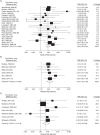Parental, In Utero, and Early-Life Exposure to Benzene and the Risk of Childhood Leukemia: A Meta-Analysis
- PMID: 26589707
- PMCID: PMC4751231
- DOI: 10.1093/aje/kwv120
Parental, In Utero, and Early-Life Exposure to Benzene and the Risk of Childhood Leukemia: A Meta-Analysis
Abstract
Benzene is an established cause of adult leukemia, but whether it is associated with childhood leukemia remains unclear. We conducted a meta-analysis in which we reviewed the epidemiologic literature on this topic and explored causal inference, bias, and heterogeneity. The exposure metrics that we evaluated included occupational and household use of benzenes and solvents, traffic density, and traffic-related air pollution. For studies of occupational and household product exposure published from 1987 to 2014, the summary relative risk for childhood leukemia was 1.96 (95% confidence interval (CI): 1.53, 2.52; n = 20). In these studies, the summary relative risk was higher for acute myeloid leukemia (summary relative risk (sRR) = 2.34, 95% CI: 1.72, 3.18; n = 6) than for acute lymphoblastic leukemia (sRR = 1.57; 95% CI: 1.21, 2.05; n = 14). The summary relative risk was higher for maternal versus paternal exposure, in studies that assessed benzene versus all solvents, and in studies of gestational exposure. In studies of traffic density or traffic-related air pollution published from 1999 to 2014, the summary relative risk was 1.48 (95% CI: 1.10, 1.99; n = 12); it was higher for acute myeloid leukemia (sRR = 2.07; 95% CI: 1.34, 3.20) than for acute lymphoblastic leukemia (sRR = 1.49; 95% CI: 1.07, 2.08) and in studies that involved detailed models of traffic pollution (sRR = 1.70; 95% CI: 1.16, 2.49). Overall, we identified evidence of associations between childhood leukemia and several different potential metrics of benzene exposure.
Keywords: benzene; cancer; childhood; leukemia; occupation.
© The Author 2015. Published by Oxford University Press on behalf of the Johns Hopkins Bloomberg School of Public Health. All rights reserved. For permissions, please e-mail: journals.permissions@oup.com.
Figures


Comment in
-
Residential Proximity to Gasoline Stations and Risk of Childhood Leukemia.Am J Epidemiol. 2017 Jan 1;185(1):1-4. doi: 10.1093/aje/kww130. Epub 2016 Dec 6. Am J Epidemiol. 2017. PMID: 27923798 Free PMC article.
-
Steinmaus and Smith Respond to "Proximity to Gasoline Stations and Childhood Leukemia".Am J Epidemiol. 2017 Jan 1;185(1):5-7. doi: 10.1093/aje/kww133. Epub 2016 Dec 6. Am J Epidemiol. 2017. PMID: 27923799 Free PMC article.
Similar articles
-
Parental occupational exposure to benzene and the risk of childhood cancer: A census-based cohort study.Environ Int. 2017 Nov;108:84-91. doi: 10.1016/j.envint.2017.07.022. Epub 2017 Aug 9. Environ Int. 2017. PMID: 28802171
-
Parental occupational exposure to benzene and the risk of childhood and adolescent acute lymphoblastic leukaemia: a population-based study.Occup Environ Med. 2019 Aug;76(8):527-529. doi: 10.1136/oemed-2019-105738. Epub 2019 May 28. Occup Environ Med. 2019. PMID: 31138675 Free PMC article.
-
Parental occupational exposure to pesticides, animals and organic dust and risk of childhood leukemia and central nervous system tumors: Findings from the International Childhood Cancer Cohort Consortium (I4C).Int J Cancer. 2020 Feb 15;146(4):943-952. doi: 10.1002/ijc.32388. Epub 2019 May 24. Int J Cancer. 2020. PMID: 31054169 Free PMC article.
-
Parental alcohol consumption and risk of leukemia in the offspring: a systematic review and meta-analysis.Eur J Cancer Prev. 2017 Sep;26(5):433-441. doi: 10.1097/CEJ.0000000000000350. Eur J Cancer Prev. 2017. PMID: 28379884 Review.
-
Exposure to pesticides and childhood leukemia risk: A systematic review and meta-analysis.Environ Pollut. 2021 Sep 15;285:117376. doi: 10.1016/j.envpol.2021.117376. Epub 2021 May 18. Environ Pollut. 2021. PMID: 34380208 Review.
Cited by
-
Traffic Density Exposure, Oxidative Stress Biomarkers and Plasma Metabolomics in a Population-Based Sample: The Hortega Study.Antioxidants (Basel). 2023 Dec 15;12(12):2122. doi: 10.3390/antiox12122122. Antioxidants (Basel). 2023. PMID: 38136241 Free PMC article.
-
Linking Benzene, in Utero Carcinogenicity and Fetal Hematopoietic Stem Cell Niches: A Mechanistic Review.Int J Mol Sci. 2023 Mar 28;24(7):6335. doi: 10.3390/ijms24076335. Int J Mol Sci. 2023. PMID: 37047305 Free PMC article. Review.
-
Effect of In utero Exposure to Air Pollution on Adulthood Hospitalizations.J Urban Health. 2024 Feb;101(1):92-108. doi: 10.1007/s11524-023-00803-1. Epub 2023 Dec 8. J Urban Health. 2024. PMID: 38064154 Free PMC article. Review.
-
Tobacco Smoke and Ras Mutations Among Latino and Non-Latino Children with Acute Lymphoblastic Leukemia.Arch Med Res. 2016 Nov;47(8):677-683. doi: 10.1016/j.arcmed.2016.11.016. Arch Med Res. 2016. PMID: 28476195 Free PMC article.
-
Fathers Matter: Why It's Time to Consider the Impact of Paternal Environmental Exposures on Children's Health.Curr Epidemiol Rep. 2017 Mar;4(1):46-55. doi: 10.1007/s40471-017-0098-8. Epub 2017 Jan 11. Curr Epidemiol Rep. 2017. PMID: 28848695 Free PMC article.
References
-
- Baan R, Grosse Y, Straif K, et al. A review of human carcinogens—Part F: chemical agents and related occupations. Lancet Oncol. 2009;1012:1143–1144. - PubMed
-
- Kaatsch P. Epidemiology of childhood cancer. Cancer Treat Rev. 2010;364:277–285. - PubMed
-
- Eden T. Aetiology of childhood leukaemia. Cancer Treat Rev. 2010;364:286–297. - PubMed
Publication types
MeSH terms
Substances
Grants and funding
LinkOut - more resources
Full Text Sources
Other Literature Sources
Medical

